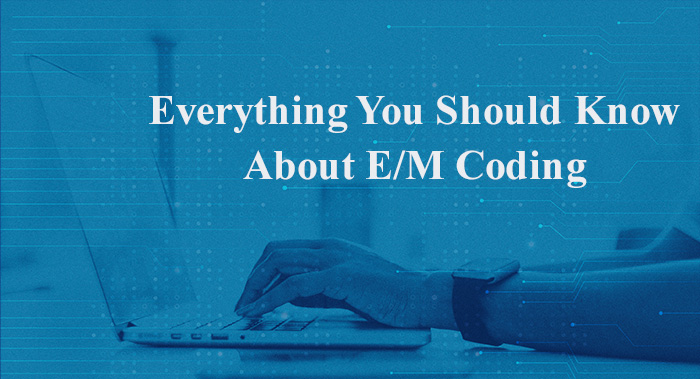
Everything You Should Know About E/M Coding
E/M coding, short for evaluation and management coding, involves CPT codes from the range 99202 to 99499 and is a system used to categorize medical services provided by healthcare professionals. E/M codes help healthcare providers communicate the level of care provided to patients to insurers for billing purposes. Understanding E/M coding is essential for healthcare providers to ensure accurate and timely service reimbursement.
What Do You Mean By E&M CPT Codes?
CPT stands for Current Procedural Terminology, which is a set of five characters or numeric coding systems maintained by the AMA (American Medical Association). However, E&M services are a part of CPT code sets. On the flip side, anesthesia, surgery, radiology procedures, pathology and laboratory procedures, and medicine services & procedures are other CPT code sets. There are dozens of E/M code categories to advance the care planning of patients. Each category has further divisions for new and already existing patients.
Furthermore, the E&M coding system is based on three key components: history, examination, and medical decision-making (MDM). The history component involves obtaining information from the patient about their medical history, symptoms, and other relevant information. The examination component involves performing a physical exam on the patient. Finally, MDM refers to the provider's thought process in determining the patient's diagnosis and treatment plan.
The E/M coding system assigns a numerical value to each of these components, ranging from one to five, with five being the most complex. Providers must document their work and select the appropriate code based on the service's complexity level. The codes are then used for billing insurers for reimbursement.
Important E/M Coding Guidelines
There are two main types of E/M codes: outpatient and inpatient. Outpatient codes are used for services provided in settings such as physician offices and clinics, while inpatient codes are used for services provided during hospital stays. Each type of code has its own set of guidelines and requirements.
One key aspect of E/M coding is the concept of medical necessity. It refers to the requirement that services must be reasonable and necessary to diagnose and treat a patient's condition. Providers must document the medical necessity of each service they provide to ensure that they are reimbursed appropriately.
Another important factor in E/M coding is the use of modifiers. Modifiers are codes that provide additional information about the service provided, such as whether it was performed by a physician assistant or nurse practitioner. Modifiers help insurers understand the full scope of the services provided and can appropriately reimburse providers.
It is essential for healthcare providers to stay up-to-date on E/M coding guidelines and requirements. In 2021, the Centers for Medicare & Medicaid Services (CMS) implemented significant changes to E/M coding guidelines, including new rules for documenting history and exam components and a new set of guidelines for coding based on MDM.
E&M Coding Changes in 2023
It's vital to stay updated with 2023 E&M coding changes, and here are the following:
Lesser Administrative Burden
Healthcare organizations deal with the overwhelming administrative burden; hence, the changes in the 2023 E&M CPT codes aim to reduce the burden instead of eliminating it. The revision consolidates the existing guidelines for office visits and facilities that render outpatient settings, including E&M services performed in hospitals, emergency departments, nursing facilities, and patient's homes. Eventually, it standardized the E&M code level determination.
Revised & Deleted CPT Codes
Many sections of CPT codes have been revised, retained, or deleted, and some of them are as follows:
- Inpatient & Observation Care Services- CPT codes 99217, 99218-99220, and 99224-99226 are deleted at the beginning of January 2023. On the other hand, CPT codes such as 99221-99223, 99231-99233, 99234-99236, and 99238 and 99239 contain the services of observation care.
- Consultation- Some changes are also made in the consultation section, such as the 99242-992245 and 99252-99255 codes have been revised.
- Emergency Department Services- AMA's recent guidelines have changed the E&M leveling based on medical decision-making (MDM) or usage time. As per this change, emergency department CPT codes 99281-99285 require a medically appropriate history.
- Nursing Facility Services- In 2023, 99304-99310, 99315, and 99316 codes are revised, and the 99318 (nursing facility assessment) code has been eliminated from the service.
- Home and Residence Services- The domiciliary, rest home, or custodial care services subsection has no usage in the 2023 updated CPT codes. The guidelines are revised for these services. Patient codes 99324-99328 and 99334-99337, and supervision codes 99339 and 99340 are also deleted from the section.
- Prolonged Service- In the recent 2023 changes, face-to-face prolonged care codes 99354-99357 are removed. These services are divulged through the office or home prolonged service code 99417 or the new inpatient/observation/nursing facility code 993X0.
Don't Let Changes Affect Your Revenue
Changes are inevitable in the healthcare sector; thus, healthcare providers should work closely with their billing and coding teams to ensure that they are correctly coding their services. Billing and coding teams can provide valuable support and guidance in navigating the complexities of E/M coding and ensuring accurate and timely reimbursement.
In conclusion, E/M coding is a vital system used by healthcare providers to categorize and bill medical services. Understanding E/M coding guidelines, accurately documenting services, and working closely with billing and coding teams are essential for providers to ensure accurate and timely reimbursement. By following experts' insights and guidance, like joining online conferences, healthcare providers can focus on providing high-quality care to their patients while also ensuring financial sustainability for their practices.




